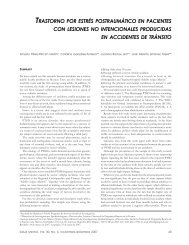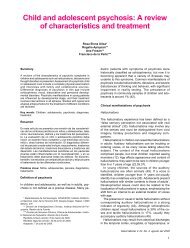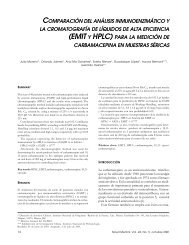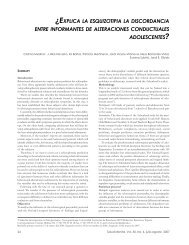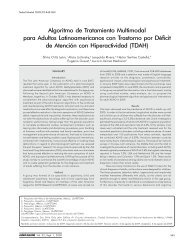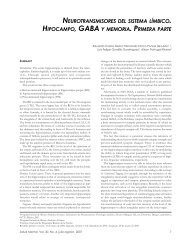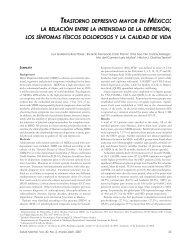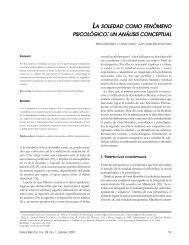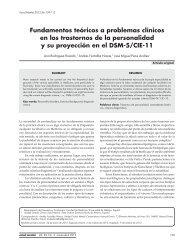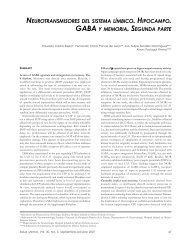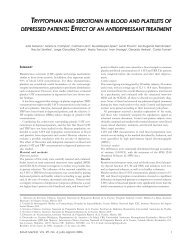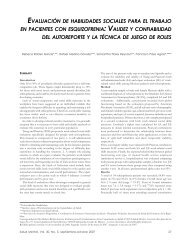Electroencefalograma y potenciales relacionados con eventos en el
Electroencefalograma y potenciales relacionados con eventos en el
Electroencefalograma y potenciales relacionados con eventos en el
You also want an ePaper? Increase the reach of your titles
YUMPU automatically turns print PDFs into web optimized ePapers that Google loves.
Garc<strong>el</strong>l y Rueda Medina<br />
ci<strong>en</strong>tes <strong>con</strong> TOC bajo tratami<strong>en</strong>to farmacológico, pero sí<br />
observaron una asociación negativa significativa <strong>en</strong>tre la<br />
amplitud de la NRE y la int<strong>en</strong>sidad d<strong>el</strong> trastorno.<br />
Hajcak et al. 56 evaluaron la NRE <strong>en</strong> un grupo de sujetos<br />
<strong>con</strong> TOC infantil y observaron un increm<strong>en</strong>to <strong>en</strong> la<br />
negatividad de este compon<strong>en</strong>te <strong>en</strong> <strong>el</strong> grupo de paci<strong>en</strong>tes<br />
<strong>con</strong> TOC <strong>en</strong> comparación al grupo <strong>con</strong>trol, lo cual <strong>con</strong>cuerda<br />
<strong>con</strong> lo observado <strong>en</strong> estudios de NRE <strong>en</strong> adultos<br />
<strong>con</strong> este trastorno.<br />
Además, la NRE no se r<strong>el</strong>acionó <strong>con</strong> la gravedad de la<br />
sintomatología ni <strong>con</strong> la respuesta al tratami<strong>en</strong>to <strong>con</strong> terapia<br />
cognitivo-<strong>con</strong>ductual, por lo que esta alteración de la<br />
NRE <strong>en</strong> <strong>el</strong> TOC pudiera ser un indicador de rasgo más que<br />
de estado. Con base <strong>en</strong> lo anterior, este grupo de investigadores<br />
propusieron que <strong>el</strong> increm<strong>en</strong>to <strong>en</strong> la amplitud de la<br />
NRE pudiera ser <strong>con</strong>siderado como un marcador biológico<br />
d<strong>el</strong> TOC.<br />
CONCLUSIONES<br />
Exist<strong>en</strong> evid<strong>en</strong>cias de que <strong>el</strong> TOC es una <strong>en</strong>tidad clínica<br />
heterogénea, <strong>con</strong> alteraciones que sugier<strong>en</strong> una disfunción<br />
cerebral amplia y compleja, lo cual apoya la necesidad de<br />
un <strong>en</strong>foque multidisciplinario para su evaluación. En este<br />
<strong>con</strong>texto, los aportes d<strong>el</strong> EEG y los PREs pued<strong>en</strong> <strong>con</strong>tribuir<br />
de manera importante, <strong>con</strong>juntam<strong>en</strong>te <strong>con</strong> los estudios<br />
clínicos e imag<strong>en</strong>ológicos, a la id<strong>en</strong>tificación de las<br />
estructuras y circuitos involucrados <strong>en</strong> su fisiopatología.<br />
Además, hay evid<strong>en</strong>cias que apoyan la utilidad de estas técnicas<br />
<strong>el</strong>ectrofisiológicas como estudios complem<strong>en</strong>tarios <strong>en</strong><br />
la evaluación clínica y terapéutica de los paci<strong>en</strong>tes <strong>con</strong> TOC.<br />
En la medida <strong>en</strong> que se logr<strong>en</strong> avances <strong>en</strong> este s<strong>en</strong>tido, cada<br />
vez será más probable la caracterización adecuada de los<br />
distintos subgrupos de paci<strong>en</strong>tes <strong>con</strong> TOC así como <strong>el</strong> desarrollo<br />
de medidas terapéuticas, e incluso prev<strong>en</strong>tivas, que<br />
mejor<strong>en</strong> la calidad de vida de estos paci<strong>en</strong>tes.<br />
AGRADECIMIENTOS<br />
Los autores desean expresar su agradecimi<strong>en</strong>to a Carlos A. Peña y<br />
a Héctor B<strong>el</strong>mont por su apoyo <strong>en</strong> las figuras de la sección de EEG.<br />
REFERENCIAS<br />
1. Attiullah N, Eis<strong>en</strong> JL, Rasmuss<strong>en</strong> SA. Clinical features of obsessive-compulsive<br />
disorder. Psychiatr Clin North Am 2000;23(3):469-91.<br />
2. Anderson KE, Savage SR. Cognitive and neurobiological findings in obsessive–compulsive<br />
disorder. Psychiatr Clin North Am 2004;27(1):37-47.<br />
3. Szeszko PR, Ardekani BA, Ashtari M, Malhotra AK, Robinson DG et al.<br />
White matter abnormalities in obsessive-compulsive disorder: a diffusion<br />
t<strong>en</strong>sor imaging study. Arch G<strong>en</strong> Psychiatry 2005;62(7):782-790.<br />
4. Val<strong>en</strong>te AAJR, Migu<strong>el</strong> EC, Castro CC, Amaro EJR, Duran FL et al. Regional<br />
gray matter abnormalities in obsessive-compulsive disorder: a<br />
vox<strong>el</strong>-based morphometry study. Biol Psychiatry 2005;58(6):479-487.<br />
5. Picton TW, B<strong>en</strong>tin S, Berg P, Donchin E, Hillyard SA et al. Guid<strong>el</strong>ines for<br />
using human ev<strong>en</strong>t-r<strong>el</strong>ated pot<strong>en</strong>tials to study cognition: recording standards<br />
and publication criteria. Psychophysiology 2000; 37(2):127-152.<br />
6. Prichep LS, Mas F, Hollander E, Liebowitz M, John ER et al. Quantitative<br />
<strong>el</strong>ectro<strong>en</strong>cephalographic subtyping of obsessive-compulsive disorder.<br />
Psychiatry Res 1993;50(1):25-32.<br />
7. Ricardo-Garc<strong>el</strong>l J. Clinical homog<strong>en</strong>eity vs EEG heterog<strong>en</strong>eity in psychiatric<br />
illness. Att<strong>en</strong>tion Deficit Hyperactivity Disorder a good example.<br />
Guadalajara, Mexico: International Meeting of Mind & Electrophysiology;<br />
2005; p 265-266.<br />
8. Pac<strong>el</strong>la BL, Polatin P, Nagler SH. Clinical and EEG studies in obsessivecompulsive<br />
states. Am J Psychiatry 1949;100:830-838.<br />
9. Ins<strong>el</strong> TR, Donn<strong>el</strong>ly EF, Lalakea ML, Alterman IS, Murphy DL. Neurological<br />
and neuropsychological studies of pati<strong>en</strong>ts with obsessive- compulsive<br />
disorder. Biol Psichiatry 1983;18:741-751.<br />
10. J<strong>en</strong>ike MA, Brotman AW. The EEG in obsessive-compulsive disorder. J<br />
Clin Psychiatry 1984;45(3):122-124.<br />
11. Rockw<strong>el</strong>l FV, Simons DJ. The <strong>el</strong>ectro<strong>en</strong>cephalogram and personality<br />
organization in the obsessive-compulsive reactions. Arch Neurol<br />
Psychiatry 1947; 57:71-80.<br />
12. Perros P, Young ES, Ritson JJ, Price GW, Mann P. Power spectral EEG<br />
analysis and EEG variability in obsessive-compulsive disorder. Brain<br />
Topography 1992;4(3):187-192.<br />
13. Marsch GR, McCall VW. Sleep disturbances in psychiatric disease.<br />
En: Ebersole JS (ed.). Ambulatory EEG monitoring. New York: Rav<strong>en</strong><br />
Press; 1989.<br />
14. Livanov MN. Information processing in the nervous system. Trabajo<br />
pres<strong>en</strong>tado <strong>en</strong> <strong>el</strong> XXII Congreso Internacional de Ci<strong>en</strong>cias Fisiológicas,<br />
Leid<strong>en</strong>. Amsterdam: Excerpta Medica Foundation; 1962; p. 899.<br />
15. Aslanov AS. On various features of the spatial distribution of biopot<strong>en</strong>tials<br />
in the cerebral cortex of pati<strong>en</strong>ts with an obsessive neurosis. Zh<br />
Nevropatol Psikhiatr Im S S Korsakova 1968;68(7):1019-1026.<br />
16. Ricardo-Garc<strong>el</strong>l J. Aportes d<strong>el</strong> <strong>el</strong>ectro<strong>en</strong>cefalograma <strong>con</strong>v<strong>en</strong>cional y <strong>el</strong><br />
análisis de frecu<strong>en</strong>cias para <strong>el</strong> estudio d<strong>el</strong> Trastorno por Déficit de At<strong>en</strong>ción.<br />
Primera parte. Salud M<strong>en</strong>tal 2004;27(1):22-27.<br />
17. Ricardo-Garc<strong>el</strong>l J, Galindo y Villa G. El Trastorno por Déficit de At<strong>en</strong>ción:<br />
un <strong>en</strong>foque multidisciplinario. Revista Latina de P<strong>en</strong>sami<strong>en</strong>to y<br />
L<strong>en</strong>guaje, número monográfico («Electrofisiología y Cognición»)<br />
2004;6(2B):247-270.<br />
18. Matousek M, Peters<strong>en</strong> I. Frequ<strong>en</strong>cy analysis of the EEG in normal childr<strong>en</strong><br />
and adolesc<strong>en</strong>ts. En: K<strong>el</strong>laway P, Peters<strong>en</strong> I (eds.). Automatic assessm<strong>en</strong>t<br />
of the EEG. New York: Rav<strong>en</strong> Press; 1973.<br />
19. John ER, Ahn H, Prichep L, Trepetin M, Brown D et al. Dev<strong>el</strong>opm<strong>en</strong>tal<br />
equations for the EEG. Sci<strong>en</strong>ce 1980;210:1255-1258.<br />
20. Harmony T, Marosi E, Díaz De León AE, Becker J, Fernández T. Effect<br />
of sex, psychosocial disadvantages and biological risk factors on EEG<br />
maturation. Electro<strong>en</strong>ceph Clin Neurophysiol 1990;75:482-491.<br />
21. Harmony T, Fernández-Bouzas A. Mapeo d<strong>el</strong> EEG <strong>en</strong> <strong>el</strong> estudio de los<br />
paci<strong>en</strong>tes <strong>con</strong> lesiones expansivas intracraneales. Archivos Clínica Neurológica<br />
Querétaro 1995;4:20-24.<br />
22. Bucci P, Mucci A, Volpe U, Merlotti E, Galderisi S et al. Executive hyper<strong>con</strong>trol<br />
in obsessive-compulsive disorder: <strong>el</strong>ectrophysiological and neuropsychological<br />
indices. Clin Neurophysiol 2004;115(6):1340-1348.<br />
23. Khanna S. Obsessive-Compulsive disorder: is there a frontal lobe dysfunction?<br />
Biol Psychiatry 1988;24:602-613.<br />
24. Molina V, Montz R, Pérez-Castejon MJ, Martin-Loeches M, Carreras JL<br />
et al. Cerebral perfusion, <strong>el</strong>ectrical activity, and effects of serotoninergic<br />
treatm<strong>en</strong>t in obsessive-compulsive disorder. Neuropsychobiology<br />
1995;32:139-148.<br />
25. Karadag F, Oguzhanoglu NK, Kurt T, Oguzhanoglu A, Atesci F et al.<br />
Quantitative EEG analysis in obsessive compulsive disorder. Int J Neurosci<br />
2003;113(6):833-847.<br />
26. Pogar<strong>el</strong>l O, Juck<strong>el</strong> G, Mavrogiorgou P, Mulert C, Folkerts M et al.<br />
Symptom-specific EEG power corr<strong>el</strong>ations in pati<strong>en</strong>ts with obsessivecompulsive<br />
disorder. Int J Psychophysiol 2006;62(1):87-92.<br />
180 Vol. 32, No. 2, marzo-abril 2009



